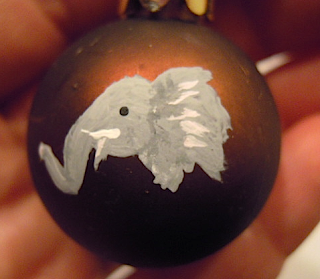My best friend and I were at a craft fair last week, where we saw hand-painted Christmas ornaments. Although they were pretty, I thought it would be fun to try painting my own.
Traditional round Christmas ornaments are known as "baubles". Invented by Hans Greiner in the small German town of Lausha, baubles have been in production since 1847.
Early Christmas trees were decorated with natural materials such as strings of popcorn and cranberries, as well as apples, pastries shaped like stars and flowers, and candy canes. The first glass baubles were thus garlands of glass beads similar to stands of popcorn.
Artisans heated glass tubes over a flame, then placed each tube into a clay mould, blowing through the tube of molten glass until it filled the mould. When the glass cooled, silver nitrate was swirled around the inside. Once the nitrate was dry, the outside of the ornament was painted by hand, then given a cap and hook.
The growing popularity of Christmas baubles led other glassblowers in Lauscha to begin production. Soon, all of Germany was buying Christmas glass from Lauscha. When a picture of Queen Victoria's Christmas tree was published in the 1850s, it featured baubles from Germany, and Lauscha was soon exporting Christmas ornaments all over Europe.
In 1870, the first glass ornaments were being produced in New York by a German artisan. By the 1880s, American retailer F.W. Woolworth had discovered Lauscha's baubles on a visit to Germany. He began importing them into the United States, making a fortune in the process. By the early twentieth century, Woolworth's had imported 200,000 ornaments from Germany.
 |
| Typical Christmas bauble. Photo: Esra Source: http://en.wikipedia.org/wiki/File:Christbaumkugel.jpg |
Following the Second World War, the East German government turned most of Lauscha's glassworks into state-owned companies, and bauble production ceased. After the fall of the Berlin Wall, most of the firms were re-established as private companies. In 2009, there were about twenty small glass-blowing companies in Lauscha, still producing baubles.
Today, although glass baubles are still widely available, baubles are more often made of plastic and other materials.
For today's elephant, I used a small bauble that came in a set of ornaments my sister bought me. It's an interesting brownish claret colour, which I thought would set off the little elephant quite nicely. Luckily, I had two, just in case I screwed up.
I started by painting a silhouette in grey.
After letting that dry for about half an hour, I painted some pink in the ears and trunk, then painted a tusk, an eye, and added a bit of shading in a darker grey.
Next, I added a gold crown.
Then, because it's less than two weeks to Christmas, I added a tiny wreath of holly around its neck.
It still looked a bit bare, so I added spots of silver snow all the way around.
I love this little ornament. I wasn't sure how it would turn out, given that I've never painted on anything round before, but I'm quite fond of it, and may make one or two more at some point.
Elephant Lore of the Day
The Cremona Elephant was likely an Asian elephant, and was presented to the Holy Roman Emperor Frederick II by the Sultan of Egypt, Al-Kamil, in 1229.
Frederick was quite taken with the gift, and used the elephant in his parades. The Cremona Elephant is mentioned in written sources as late as 1241, but little else is known about it. The Cremona Elephant was the first known elephant in Europe since Abul Abbas, who was owned by Charlemagne.
I mostly just like the picture.
To Support Elephant Welfare
World Society for the Protection of Animals
Elephant sanctuaries
(this Wikipedia list allows you to click through to information on a number of sanctuaries around the world)
Performing Animal Welfare Society
Zoocheck
Bring the Elephant Home
African Wildlife Foundation
Performing Animal Welfare Society
Zoocheck
Bring the Elephant Home
African Wildlife Foundation








No comments:
Post a Comment